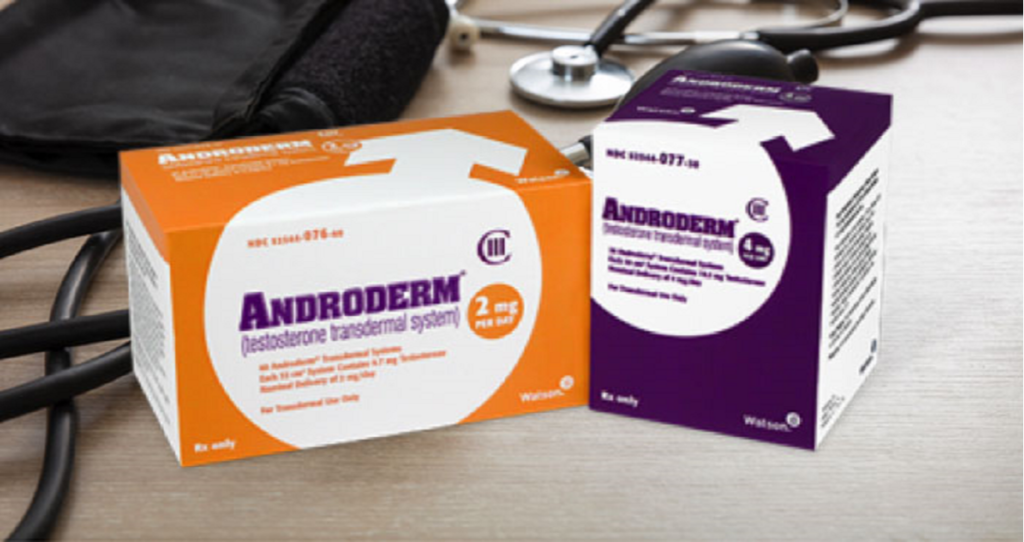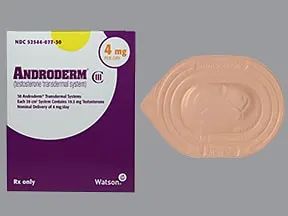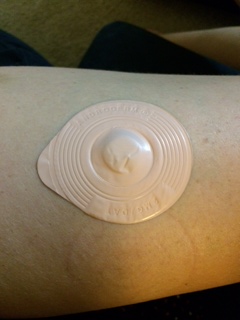Androderm
Androderm is a transdermal testosterone medication, kinda like those testosterone gels such as AndroGel. It’s pretty popular for treating low testosterone levels, and it’s actually stronger than the gels. Androderm has double the bioavailability compared to AndroGel. Also, unlike AndroGel, Androderm comes in the form of a patch that you stick directly onto your skin.

It was first developed back in the early 1990s by TheraTech and got FDA approval in 1995. Although Watson owns the brand name now, there are other transdermal testosterone patches available, like ATMOS by Astra, mostly found in Europe.
Androderm is quite effective for combating low testosterone, next to injectable testosterone. But despite its success, it’s not as widely used as the injectable or gel forms. And you don’t really see it much in performance enhancement circles. It could work for that purpose, but you’d need several patches for a noticeable performance boost, which makes it kinda inefficient.
What is Androderm
Androderm is a gel containing testosterone, delivered through a skin patch. It’s designed to release testosterone steadily, mimicking the body’s natural hormone production. This means you get more testosterone in the morning, with levels tapering off later in the day. Peak levels usually occur around 12 hours after applying the patch.
It comes in two strengths: 2.5mg and 5mg patches, providing 12.2mg and 24.3mg of active testosterone respectively. The dosage varies from person to person, making it suitable for testosterone replacement therapy (TRT). Low testosterone, often due to aging, can lead to various symptoms that Androderm aims to alleviate. These symptoms include:
- Decreased energy
- Reduced muscle mass
- Low sex drive
- Mood changes
If you’re experiencing these symptoms, consider talking to your doctor about Androderm. They can perform tests to confirm if low testosterone is the cause.
Testosterone levels and prostate cancer
Understanding the link between testosterone levels and prostate cancer is complex. While low testosterone alone may not directly cause prostate cancer, it can potentially contribute to its development and progression. Testosterone is essential for the prostate gland’s growth and maintenance, but it also serves as fuel for prostate cancer cells. However, the situation isn’t straightforward. Prostate cancer cells have receptors for testosterone, allowing them to respond to it and grow. Interestingly, some studies suggest that these cells can become more aggressive in the presence of lower testosterone levels.
Hormone therapy is often used to manage conditions linked to low testosterone, including prostate cancer. However, reducing testosterone levels through this therapy may have unintended consequences. Cancer cells that initially respond to hormone therapy might become resistant over time, making treatment more challenging. Additionally, low testosterone levels can lead to inflammation in the prostate gland, which is thought to contribute to prostate cancer development. Testosterone has anti-inflammatory effects, so lower levels might provide less protection against inflammation-related damage.
It’s important to remember that prostate cancer isn’t solely influenced by testosterone levels. Genetics, age, diet, lifestyle, and environmental factors all play roles in prostate cancer risk. While low testosterone levels may contribute to prostate cancer development in various ways, they’re just one part of a bigger picture. More research is needed to fully understand how testosterone interacts with other factors in prostate cancer development and progression.
Androderm Effects
The impact of Androderm is straightforward, perhaps even more so than many other anabolic steroidal compounds. When an individual experiences low testosterone levels, whether due to various reasons, they no longer produce an adequate amount of this primary androgen. By adopting a Testosterone Replacement Therapy (TRT) regimen, Androderm effectively addresses this condition. While low testosterone is often a chronic condition without a cure, Androderm offers an ideal treatment solution. Continuous, lifelong treatment might seem bothersome, but it does not adversely affect daily life; it simply involves applying a patch upon waking and carrying on with the day.
Consider this essential question: would you prefer to manage your low-level condition or endure the consequences of untreated low testosterone?

Thanks to Androderm, many men experience significant improvements in their lives. Those in their 40s, 50s, and beyond frequently report a better quality of life compared to their 30s or even their 20s. TRT recipients tend to experience fewer illnesses, increased energy levels, and a greater enthusiasm for life. They often look and feel better, leading to an overall sense of happiness and well-being. These positive outcomes can be attributed to the effects of Androderm. If you suffer from low testosterone, there is little rationale for not pursuing treatment.
Androderm side effects
Most adult men tolerate external testosterone well. Side effects with TRT are rare. However, Androderm can cause some side effects. The amount of testosterone that’s safe varies from person to person. It’s important to remember that TRT aims to replace what the body lacks. While synthetic testosterone is used, once in the body, it’s the same as natural testosterone. Taking too much testosterone can increase side effects, but reasonable doses are usually safe. We’ve categorized Androderm’s potential side effects for easy understanding.
About Estrogen
Androderm may cause estrogen-like side effects, such as gynecomastia (breast tissue growth) and excess water retention, which can lead to high blood pressure if severe. These effects happen because testosterone interacts with an enzyme called aromatase, which converts testosterone to estrogen. When estrogen levels rise, these side effects can occur.
To prevent estrogenic side effects from Androderm, some men may require medication. There are two types of medications that can help: Selective Estrogen Receptor Modulators (SERMs) and Aromatase Inhibitors (AIs). SERMs like Tamoxifen Citrate (Nolvadex) work by binding to estrogen receptors, preventing estrogen from binding. AIs like Anastrozole (Arimidex) reduce estrogen levels by inhibiting the aromatase process. AIs are more effective, but not always necessary. Many men on TRT may not need any anti-estrogen medication, but these options are available if needed.
Masculinising Side Effects
Androderm side effects can include those related to male hormones. These may manifest as acne, increased hair loss in men prone to baldness, and more body hair growth. However, whether you experience these side effects depends largely on your genetics. If you aren’t genetically prone to baldness, Androderm won’t cause hair loss. If you are, you may lose hair regardless of Androderm, but its use could speed up the process.
These potential side effects happen because testosterone in Androderm gets metabolized by an enzyme called 5-alpha reductase, which converts it into dihydrotestosterone (DHT). Some men might find a 5-alpha reductase inhibitor like Finasteride helpful, as it reduces the hormone’s androgenic effects. However, it’s unlikely you’ll need Finasteride or any similar drug during TRT. Remember, TRT aims to replace the testosterone your body lacks and nothing more.
Heart blood pressure and cholesterol
Androderm may cause high blood pressure due to water retention, but this risk is low with the prescribed low doses. If water retention occurs, it can be managed with anti-estrogen medication. Exogenous testosterone can also affect cholesterol by reducing HDL (“good”) cholesterol levels. However, therapeutic or moderate doses of testosterone alone don’t seem to significantly worsen cholesterol. But when testosterone is combined with an aromatase inhibitor (AI), it can reduce HDL levels. However, using a Selective Estrogen Receptor Modulator (SERM) can actually improve cholesterol levels.
To avoid cholesterol issues, limit saturated fats and sugars and include plenty of omega fatty acids in your diet. Daily fish oil supplements and regular cardiovascular exercise can help maintain healthy cholesterol levels.
Androderm and the liver
Androderm is not harmful to the liver, as it is not a hepatotoxic anabolic steroid.
Skin Irritation: About one in twenty men using Androderm may experience skin irritation at the patch application site. If this happens, you may need to switch to other forms of testosterone treatment, such as injectable testosterone or testosterone implant pellets. Hydrocortisone cream can help alleviate the irritation.
How to take Androderm

Androderm patches are applied directly to the skin in the morning on areas like the upper arms, back, shoulders, thighs, or abdomen. It’s important to apply them to clean, dry skin, preferably after taking a shower. To prevent irritation, rotate the application sites and avoid areas that will experience constant pressure, like the rear end or areas on the back.
Using over-the-counter ointments or creams with Androderm is not recommended as they can reduce its effectiveness. Typically, most Androderm plans involve applying two 2.5mg patches or one 5mg patch per day for several weeks. Afterward, testosterone levels are checked, and a maintenance plan is prescribed.
Conclusion
Androderm is a highly effective TRT medication, often underestimated. However, its cost is considerably higher compared to most testosterone compounds, which may not be justified by its benefits. Injectable testosterone is typically cheaper and more efficient overall. Nonetheless, Androderm is sufficient for many men and offers convenience as a testosterone medication.